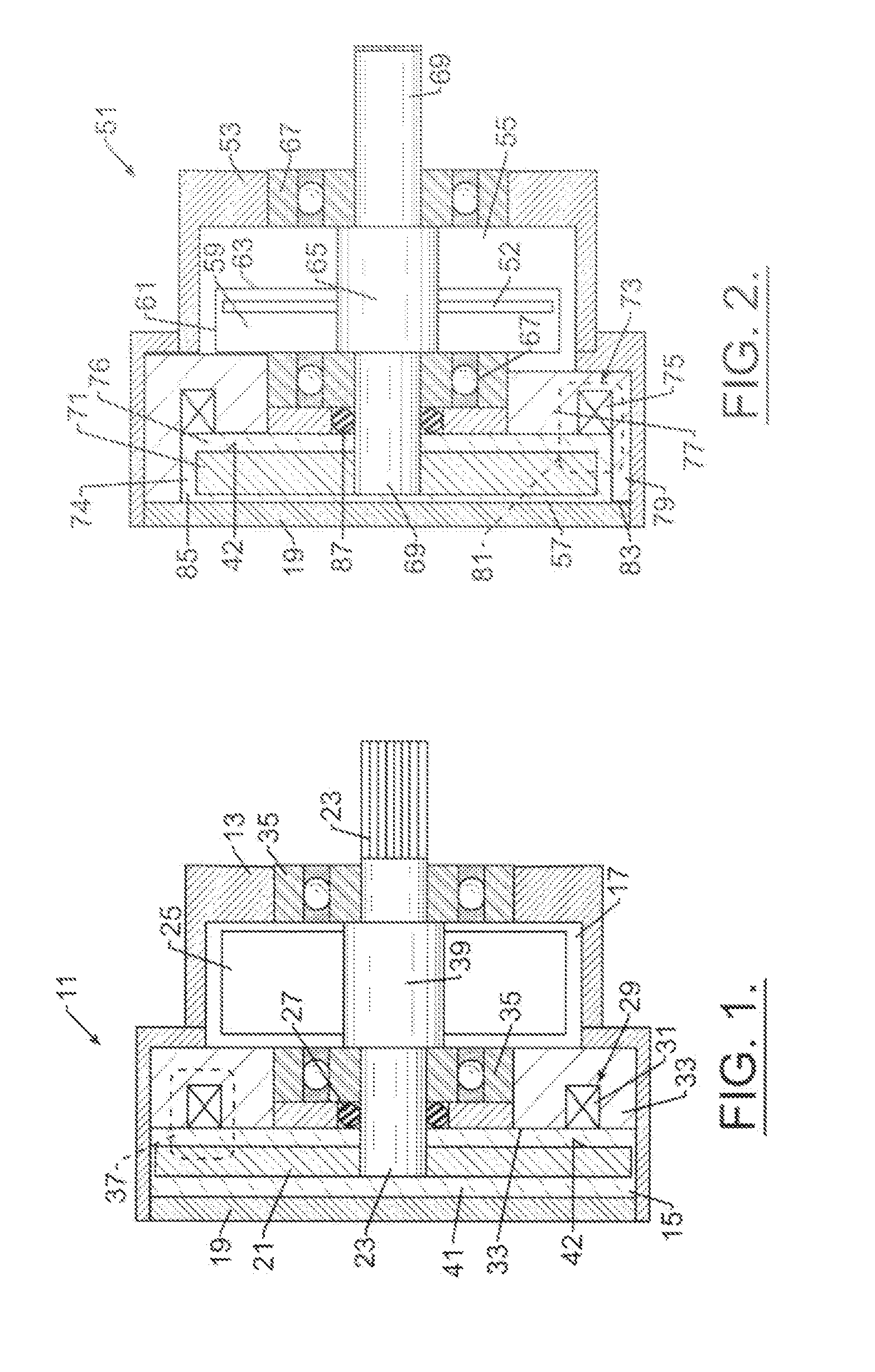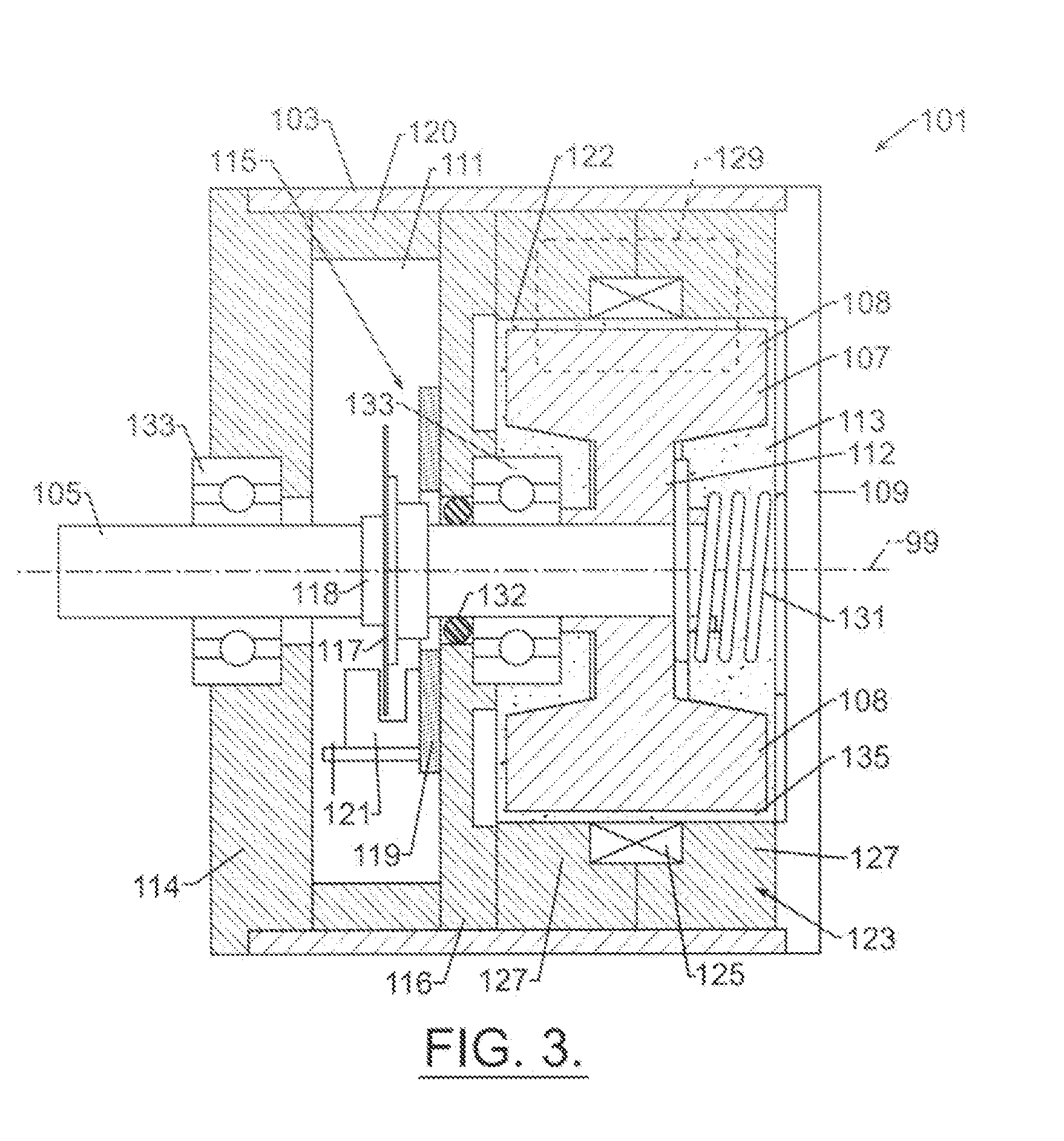Brake with field responsive material
a technology of field responsive materials and brakes, which is applied in the direction of shock absorbers, mechanical equipment, transportation and packaging, etc., can solve the problems of limited space allotted for the use of these devices, and achieve the effect of restricting relative rotation
- Summary
- Abstract
- Description
- Claims
- Application Information
AI Technical Summary
Benefits of technology
Problems solved by technology
Method used
Image
Examples
first embodiment
[0046]For purposes of describing the invention, rotor 21 is disk-shaped and is supported on a shaft 23 within the housing 13 for rotation within the housing chamber 15. The rotor includes first and second surfaces and an outer periphery. The surfaces include working portions near the outer periphery at regions on the surface of the rotor upon which the magnetic field acts. The working surface is identified at 42 in FIG. 1. A typical magnetic flux line 37 associated with the applied magnetic field is shown dashed in FIG. 1.
[0047]Brake housing 13 includes an open end where the first chamber 15 is located and the open housing end and the chamber is closed and sealed by closing plate 19. The first chamber also contains therein a volume of field controllable material 41 and electromagnetic field generators 29. The field generators comprise, for example, in one configuration, coil 31 and pole piece 33. When activated, the magnetic field generator 29 creates magnetic flux 37. In FIG. 1 the...
second embodiment
[0058]In the embodiment of FIG. 3, the seal 132 required to prevent migration of material 135 from the first chamber 113 to the second chamber 111 is shown seated in bearing support plate 116. Such a suitable seal may comprise the seal disclosed in the description of first and second embodiment brakes. The suitable conventional seal may be supported in the bearing support plate 116 or within bearings 133. An annular shroud 120 is located between plates 114 and 116. Shroud 120, in combination with plates 114 and 116 encloses the sensing means 115 within chamber 111.
[0059]Returning again to the rotor 107 of the third embodiment brake 101, rotor 107 is not substantially disk-shaped like disks 21 and 71 previously described. As shown in FIG. 3, rotor enlarged peripheral portion 108 is located proximate electromagnetic coil 125 of field generator generally identified at 123. As shown by the stippling representing field responsive material 135, an annular gap 122 separates the portion 108...
third embodiment
[0061]The third embodiment brake 101 comprises a return-to-center acting device, such as a torsion or torsional center-return spring 131 which is mounted within first housing chamber 113. Other center return devices may comprise bungee cords or other type elastic components. Generally the suitable center return device is any device that stores energy as the rotor and / or shaft are / is displaced from a center or start position or orientation and then at a particular displacement releases the stored energy to return the rotor and shaft to the start orientation. The particular displacement that results in a release of the stored energy may comprise for example, the operator releasing the shaft or rotor or the shaft or rotor reaching a maximum angular displacement. The torsion return spring 131 typically assumes a torque free condition at the center position of a device with which brake 101 may be associated, such as a steering wheel at the center position of the device. The return to cen...
PUM
 Login to View More
Login to View More Abstract
Description
Claims
Application Information
 Login to View More
Login to View More - R&D
- Intellectual Property
- Life Sciences
- Materials
- Tech Scout
- Unparalleled Data Quality
- Higher Quality Content
- 60% Fewer Hallucinations
Browse by: Latest US Patents, China's latest patents, Technical Efficacy Thesaurus, Application Domain, Technology Topic, Popular Technical Reports.
© 2025 PatSnap. All rights reserved.Legal|Privacy policy|Modern Slavery Act Transparency Statement|Sitemap|About US| Contact US: help@patsnap.com



